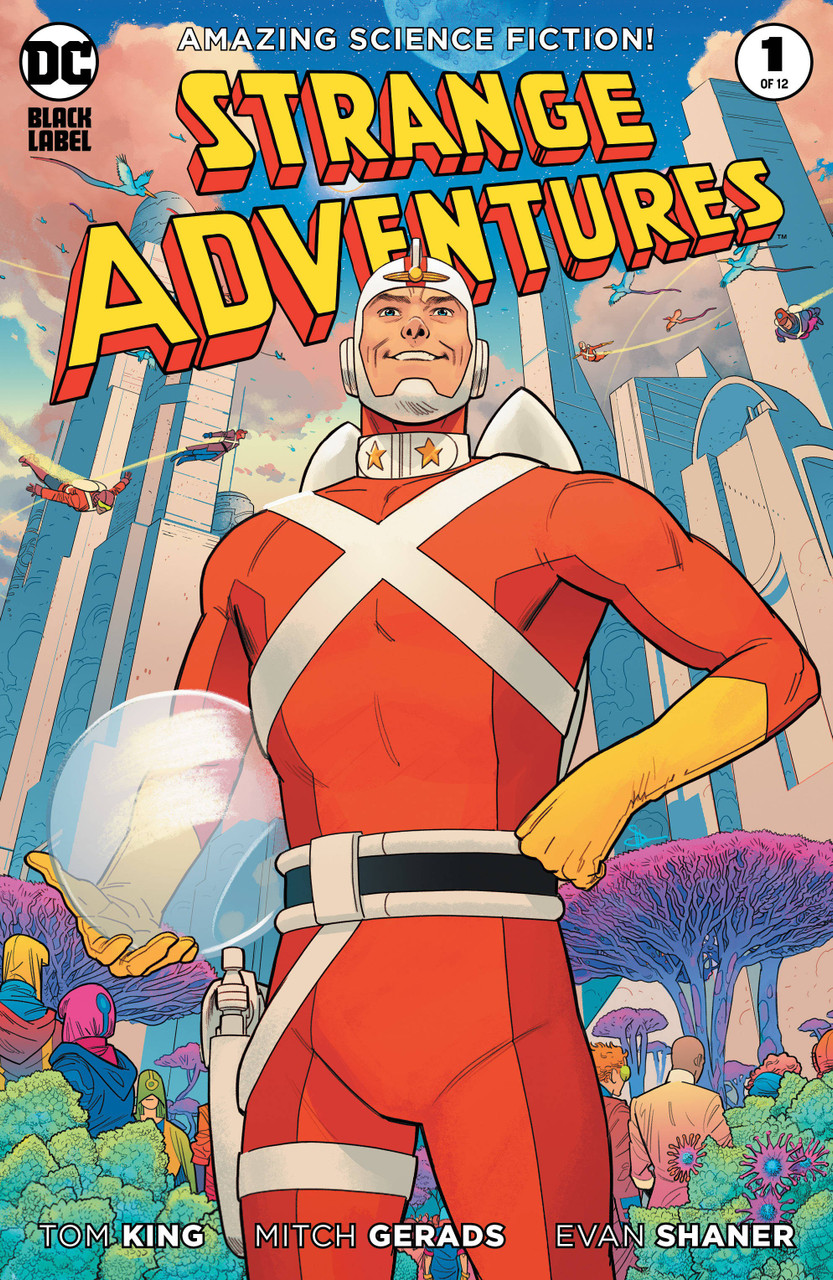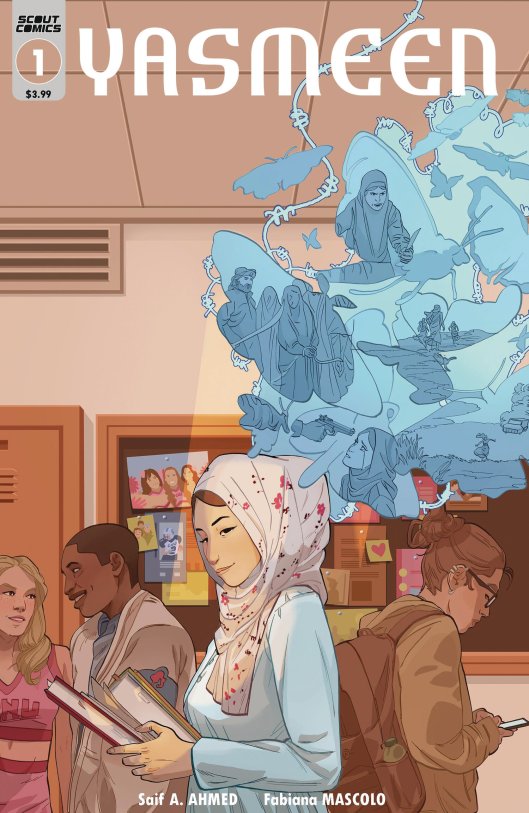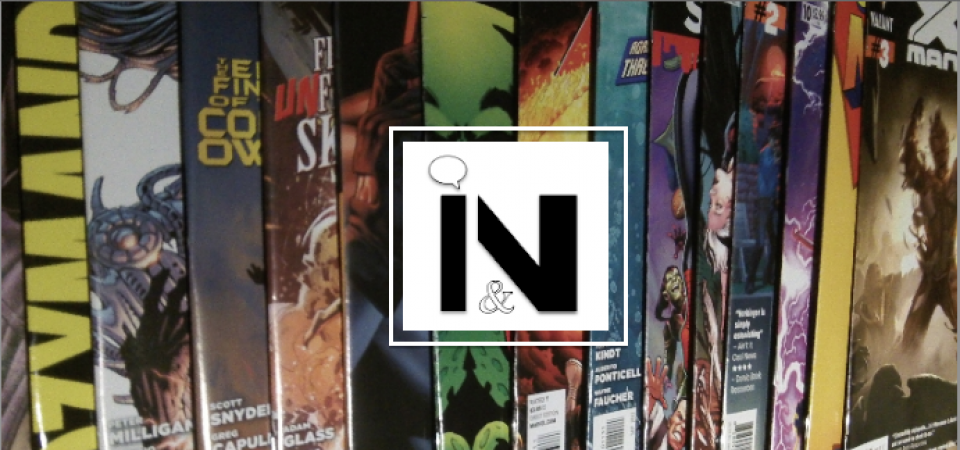Tags
Adventureman, Black Label, Brittany Peer, Chris Evenhuis, comics, DC Comics, Evan Shaner, Fabiana Mascolo, GI Joe, IDW, Immigrant, Iraq, ISIS, Matt Fraction, Mitch Gerads, Paul Allor, Rachel Dodson, reviews, Saif A. Ahmed, scout comics, Strange Adventures, Terry Dodson, Tom King, Yasmeen
By Derek Mainhart
Being a cartoonist myself, naturally I read comics. A lot. With hundreds of titles to choose from, who has the time to comb through all that content?
I do. Here are some that are worthy of your attention:
Strange Adventures (DC/Black Label): I’ll admit it: I didn’t care for Tom King’s and Mitch Gerads’ previous collaboration, Mister Miracle. Though highly lauded elsewhere, I found its mix of quotidian family life with the apocalyptic horror of war unconvincing; each aspect undercut the other. The elliptical storytelling approach, so effective in The Sheriff of Babylon and The Vision, here seemed too coy by half.
Now King and Gerads take on another classic character, Adam Strange. Strange is part of a continuum of a specific type of hero, dating back to the likes of Flash Gordon, whose role as saviors of foreign, untamed lands sits uneasily with a modern, examined view of colonialism. King and Gerads tackle this legacy head on, telling two sides of the same story. In one version, Strange saves his adopted home world from certain destruction, in classic comic book fashion. In the other, depicted more realistically in the present day, his actions are called into question, possibly amounting to war crimes. Here the juxtaposition (queasy in Mister Miracle) cuts to the heart of the historical subtext of the character, and other classic characters like him (Matt Fraction and the Dodsons are exploring similar territory in Adventureman – also worth a look). The format itself, with a different artist depicting each version of the story, provides the perfect structure for the themes being explored.
In this, King and Gerads are immeasurably aided by the addition of Evan ‘Doc’ Shaner. His clean, concise, fluid style is the perfect match for the ‘classic hero’ sections of the book. Shaner’s work effortlessly recalls the art of past greats of the genre, seemingly distilling them into a timeless sort of comic book storytelling. In the promo material King calls him a “Platonic comics ideal”. He is this generation’s Curt Swan.
Gerad’s approach is more structured and repetitive, evoking something more akin to our reality. The constant shifting between the two keeps the reader appropriately off-balance, given the subject matter.
In its critical re-examination of who and what is considered a hero, Strange Adventures couldn’t be more timely.

G.I. Joe (IDW): Yes I see you rolling your eyes: yet another man-child gripped by nostalgia for his childhood soldier-dolls. The reason to get this book, however, is writer Paul Allor. In the past, he has displayed a knack at taking established, staid properties and pushing them in unexpected, expansive directions (a couple of years back, he took Clue – yes the board game – and crafted a meta-mystery-mini-series that was at least as engaging as the beloved cult movie).
Here, he takes the concept of G.I. Joe and flips it. In this iteration, Cobra (the bad soldier-dolls of yore) has indeed conquered the world. But here’s the rub: they didn’t do it with some giant laser pointed at the sun. They accomplished it through dominating the tech sector, establishing global markets and creating a media empire. In other words they did it drip by drip, using multiple levers of control in order to convince enough people that they were better off with Cobra in charge. True, they brutally crush dissent when necessary (which is where the crux of the story lies). But that is not their only, nor even their primary, method of keeping their grip on power. The acquiescence of the population is the foremost element required. Cobra has come to power by studiously following the authoritarian playbook. Cue the real-world comparisons.
As such, the Joes, in this new reality, are seen by much of the general populace as terrorists. And they are truly a rag-tag group: scant resources, constantly on the move, and engaging in guerilla tactics (small acts of sabotage, disrupting supply chains and such – think Red Dawn, but not dumb). Indeed one of the intriguing things Allor is presenting are the internecine conflicts within the Joe’s themselves (there are at least three different factions opposing Cobra). The interpersonal conflicts of these desperate freedom fighters provides much of the tension. Imagine – G.I. Joe driven by character development!
Not that there isn’t plenty of action. The difference is that, unlike a child’s (or man-child’s) fantasy of war, violence here comes with cost. Indeed one of the issues the characters wrestle with, is if that cost, measured in their lives and the lives of others, is too high.
Artist Chris Evenhuis, working with colorist Brittany Peer, render the proceedings with a no-nonsense, clear-cut graphic style that acts as a nice counterpoint to a story in which there are so many shades of gray.
As our own democracy teeters on the verge of authoritarianism, this prescient iteration of G.I. Joe warns us what it will look like when we get there.

Alright, enough wading in pop-culture. Do weighty issues have to be tied to entertaining, escapist fare in order for people to pay attention to them? What about those rooted more firmly in reality? Which brings us to today’s final entry:
*TOP PICK*
Yasmeen (Scout Comics): Yasmeen, the remarkable debut comic by writer Saif A. Ahmed, follows the eponymous character as she survives the horrors of war, and tries to navigate what comes after. Her story unfolds along dual timelines. One takes place in Iraq in 2014 as ISIS invades the city of Mosul. The other, two years later in Iowa, as she tries to gather the strands of her life while simultaneously assimilating to a strange, new land.
In Iraq, Yasmeen lives a comfortable, even privileged life. Ahmed exposes the fragility of this seeming security with an almost casual abruptness. Violence and capture follow. The tragedy is presented with fidelity, but never gratuity. Much credit goes to the thoughtful staging and restraint shown by artist Fabiana Mascolo whom imbues the visuals with a cinematic flair for both the domestic and epic.
In Iowa, Yasmeen, having survived her ordeal, is reunited with her family. But any happiness is undercut by the changes her experiences have wrought on her, and the gulf it creates between her and those closest to her. This is compounded by the alienation she feels in her new, foreign surroundings.
While the tragedy of Iraq and neighboring Syria are well-known via news coverage, Ahmed’s focus on one teenage girl achieves the feat of making the abstract intimate, though never exploitative. This is due in large part to the story being informed by the writer’s own experiences and of those he knew. He himself escaped ISIS and immigrated to the US. Others were not so fortunate. Though the fictional Yasmeen is drawn from these sources, Ahmed breathes life into her as an individual, with care for the closely- observed details that imbue her, and the rest of the cast, with gravity and authenticity.
Ultimately this is a tale of trauma and the strength needed to heal. One of the most laudable things art can do is to give voice to the voiceless, to enable us to truly see them, and in seeing them, build empathy for their individual experience. In a world that is increasingly a patchwork of people displaced by violence, the story of Yasmeen is one of no small urgency. Highest recommendation.

